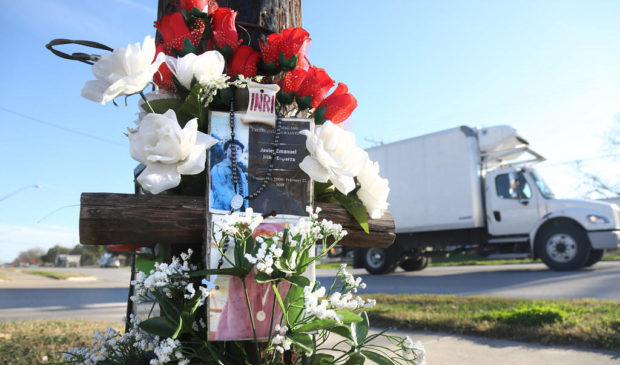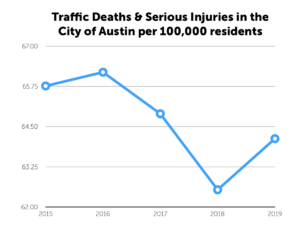Newsletter Signup
The Austin Monitor thanks its sponsors. Become one.
Most Popular Stories
- Council members celebrate unanimous defeat of bill that proposed putting Austin under state control
- A once-banned type of building is back in favor – and the Planning Commission approves
- Austin churches answer prayers for affordable housing – by building it themselves
- SOS suing state agency over failure to provide information on MoPac expansion
- Staffing isn’t the only thing to blame for Austin’s slow 911 response times
-
Discover News By District

Traffic deaths went up in Austin last year. Safety advocates ask: Where’s the moral outrage?
Wednesday, January 8, 2020 by Audrey McGlinchy, KUT
Billy Brewster loved lawnmowers. The 15-year-old, who was autistic and nonverbal, would just admire them from afar.
“Billy sometimes wouldn’t even want to use the lawnmower,” his mother, Mia Brown, said. “He just wanted to stand there and look at it.”

Mia Brown with her son, Billy Brewster, who was hit by a car and killed last September.
PHOTO COURTESY OF MIA BROWN
He also liked to leave his house in Northeast Austin and wander the neighborhood. Brown said neighbors would bring him home or she’d drive around looking for him.
That’s what she was doing on a Saturday night in late September when she saw police barricades on East Yager Lane, about two miles from her home.
“I stopped, I got out and I asked them, ‘My son is missing. He has autism and he’s just gotten out. … Does this have anything to do with my son?’” Brown said. “And they said, ‘We think that it does.’”
A driver had hit and killed Billy as he walked in the middle of the road, according to an initial report from the Austin Police Department.
“He was a very happy child all the time, always smiling, always laughing,” Brown said.
For the first time since Austin officials adopted a traffic safety plan in 2016, the number of people killed on Austin roads has gone up. Eighty-eight people, including Billy, died on city streets in 2019, up roughly 19 percent over the year before. Traffic safety advocates say the rise means the city and the state, which share ownership of Austin roads, need to double down on traffic safety.
“What happened in 2019 was horrific. There should be widespread moral outrage at what happened,” said Adam Greenfield, chair of the city’s Pedestrian Advisory Council. “It’s a public health crisis and the city needs to prioritize it as an urgent issue to address immediately.”
‘The Message Isn’t Coming Through’
In 2015, a record 102 people died on Austin roads. The next year, City Council adopted the so-called Vision Zero plan. The idea is that road deaths are not accidents but avoidable crashes, and through better enforcement, education and road design, Austin could make its streets safer. The city gave itself a goal: Reduce to zero the number of traffic deaths and serious injuries by 2025.
Until this year, the city seemed to be on that path, with traffic deaths getting down to 74 between 2015 and the start of 2019.
But auditors in September said Austin was unlikely to reach this goal, citing misdirected city funds as one of the problems.
“I don’t think the public really understands how bad it is,” said Heyden Black Walker, a traffic safety advocate and urban designer. “When I talk about fatalities and the fact that generally about 78 to 79 people die in Austin for no reason, people are shocked. Somehow the message isn’t coming through.”
Of those killed on Austin roads in 2019, roughly 40 percent of them were pedestrians – people either walking or standing when they were hit by a car. Typically, pedestrian deaths have constituted about 30-35 percent of Austin traffic fatalities.
Brown attributes her son’s death to missing sidewalks, speed, poor lighting and bad signage in that stretch of East Yager Lane.
“How many accidents does it take for you to realize that people don’t understand what it is that they’re supposed to be doing on the roads?” she said.
The rise in pedestrian deaths is part of a national trend; in 2018, the number of pedestrians killed hit a 30-year high. According to NPR, experts attributed this rise to two things: drivers distracted by cellphones and a rise in people driving bigger cars.
The Austin Police Department acknowledged it doesn’t have the data to confirm if that’s what’s causing the increase in deaths here. Instead, APD Cmdr. Eric Miesse said, people make bad decisions “by crossing midblock or crossing the interstate.”
APD said 33 of the 36 pedestrians who died on Austin’s roads last year were to blame for their deaths.
“For all of our fatalities, it’s really about decision-making,” Miesse said.
But Jay Blazek Crossley, executive director of the nonprofit Farm&City, said officials should move away from blaming people for their own deaths.
“Police do an amazing job of trying to deal with the carnage on our streets, but they are then asked to fill out a form saying, what are the human behaviors that caused this crash?” he said. “And then we study the data on that and say, look, all these crashes were caused by people making mistakes, and then blame the users.”
“Nowhere on the form does it say, was there a safe pedestrian crossing?”
Instead, Crossley said, the pressure should be on state and city governments to design, build and maintain safe roads. Traffic safety advocates are asking for several things, including lowering speed limits, increasing enforcement of impaired driving and using inexpensive materials like paint to bring driver attention back to the road.
“We need decisive leadership and action to stay on that path,” Crossley said. “The city has done tremendous work really starting on this whole idea of ending traffic deaths in the city of Austin, and I think it’s time for us to take some of the more difficult steps.”
The State’s Role
Crossley and other traffic safety advocates say the state, or the Texas Department of Transportation, also needs to take responsibility for traffic deaths. The agency owns and maintains several of Austin’s busier roads, where many fatal crashes happened last year.
More than one-fourth – 23 of 88 – of the people who died on Austin roads in 2019 were hit on Interstate 35 and its frontage roads.
But while advocates KUT spoke to for this story said they felt the city had taken responsibility for road deaths, they said they felt the state was not as willing to do so.
Walker said TxDOT’s focus is on the safety of drivers rather than pedestrians.
“It makes me angry,” she said.
A spokesperson for TxDOT said road deaths are a “shared responsibility.”
“We feel like the majority of these crashes are due to driver error,” Veronica Beyer said.
But last year, the Texas Department of Transportation did acknowledge its role in traffic deaths, adopting its own safety goal: Reduce deaths on Texas roads by half by 2035 and to zero by 2050. The agency also put aside an additional $600 million last year for improvements to intersections and pedestrian crossings.
It’s the “moral outrage” of people like Walker and Brown that advocates are looking for. Crossley said they plan to show up at City Council’s first meeting of 2020 to encourage officials to take more action.
“If we don’t reach (our goal) it’ll be because we chose not to try,” he said.
This story was produced as part of the Austin Monitor’s reporting partnership with KUT. Top Photo: A memorial at the intersection of Seventh Street and Springdale Road for Javier Emanuel Nino Esparza, who died after his car was hit by an alleged drunken driver last March. Jorge Sanhueza-Lyon/KUT.
The Austin Monitor’s work is made possible by donations from the community. Though our reporting covers donors from time to time, we are careful to keep business and editorial efforts separate while maintaining transparency. A complete list of donors is available here, and our code of ethics is explained here.
You're a community leader
And we’re honored you look to us for serious, in-depth news. You know a strong community needs local and dedicated watchdog reporting. We’re here for you and that won’t change. Now will you take the powerful next step and support our nonprofit news organization?








